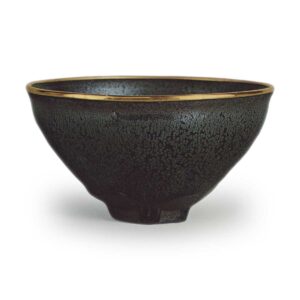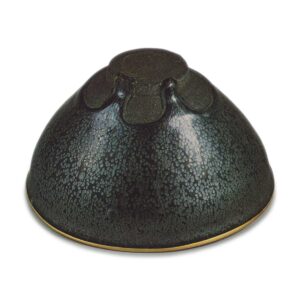

sliced raw fish, shellfish, etc.
Important Cultural Property
Important Cultural Property
Height: 6.8 – 7.0 cm
Mouth diameter: 12.5-12.8cm
Outer diameter of base: 4.0cm
Height: 0.6cm
This bowl is considered to be the twin of the Wakashu Sakai family’s tea bowls, but the Sakai family’s bowl is superior in terms of shape and form, and the Sakai family’s bowl is superior in terms of the large and vivid oil drip spots.
The oil drip is the most beautiful shape among all the Jian Chan Tianmu bowls we have seen. The body of this oil drop is taut and generous, and the line from the top to the rim of the mouth is graceful. The silvery-iron mottling is slightly smaller than that of the Sakai family’s oil drops, but it appears beautifully like the Milky Way all over the glaze, especially the grains on the inner surface are well matched and beautiful.
The two lines of glaze dripping from the base to the high plateau are as clear as if painted, and there is not a single flaw in the entire body, making it truly a perfect “true” tea bowl.
After being in the possession of Oribe Furuta, it was given to Toshikatsu Doi, then to Nagayasu Kinoshita Izumimori of Hinode, Bungo, and then to Fushimiya Fushimiya, a dokaiya in Edo, and became the property of Lord Fumai Matsudaira, and remained in his family until after the Pacific War.
Lord Fumai Matsudaira listed this tea bowl as one of the great masterpieces in his collection, and left his instructions to his heir, Dewamori Hitotsune, in September Bunka 8, 1900: “It is a masterpiece under the heaven and should be treasured for a long time.
According to the “Fushimiya Memorandum,” he paid 20 gold pieces to Lord Fumai, but the “Unshu Meibutsu Ki” records it as “70 oil drops. However, if it was 70 ryo, it is too low compared to the 500 ryo of the Kizaemon well and the 200 ryo of the Tortoiseshell cup, and if it was 20 gold pieces, it would be 200 ryo for 20 large pieces of 10 ryo, the same amount as the Tortoiseshell cup, so the 20 gold pieces in the Fushimiya Memorandum is probably correct.
The inner box is a simple box made of quarter-sawn paulownia wood, and the inscription “Yuteki Tenmoku” on the inner box is said to be by Sen no Rikyu, and the outer box is a beautiful box prepared by Lord Fumai. The bag of the tea bowl is made of purple habutae, and the inner box is wrapped in chintz. The inner box is wrapped in chintz, and a bag of small peonies on white ground is attached to the bag. In “Shoka Meikishu,” the inscription on the inner box is attributed to Furuta Oribe. Of course, it may have been handed down before Furuta Oribe, but whether or not it was a Higashiyama Gomotsu is unknown.
According to the record in the Obian bunko, it is indicated that the mouth of the vase was once covered with a silver ring, but by the time it was published in “Taisho Meikikan”, the ring was no longer covered with a silver ring. The present owner had the goldsmith Nakano Keisho put it on when he participated in the 250th anniversary exhibition of Lord Fumai in Matsue in 1966.



